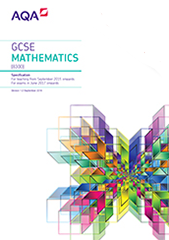Scheme of assessment
Find past papers and mark schemes, and specimen papers for new courses, on our website at aqa.org.uk/pastpapers
This specification is designed to be taken over two years with all assessments taken at the end of the course.
GCSE exams and certification for this specification are available for the first time in May/June 2017 and then every May/June and November for the life of the specification.
This is a linear qualification. In order to achieve the award, students must complete all exams in November or May/June in a single year. All assessments must be taken in the same series. November entries will only be available to students who were at least 16 on the previous 31 August. See Resits and shelf life in the General administration section for November entry restrictions.
All GCSE exams in mathematics must include questions that allow students to draw on elements from within and across different topic areas, and questions that allow students to provide extended responses.
All materials are available in English only.
Aims and learning outcomes
Courses based on this specification in mathematics should provide a broad, coherent, satisfying and worthwhile course of study. They should encourage students to develop confidence in, and a positive attitude towards, mathematics and to recognise the importance of mathematics in their own lives and to society. They should also provide a strong mathematical foundation for students who go on to study mathematics at a higher level post-16.
Courses based on this specification in mathematics should enable students to:- develop fluent knowledge, skills and understanding of mathematical methods and concepts
- acquire, select and apply mathematical techniques to solve problems
- reason mathematically, make deductions and inferences and draw conclusions
- comprehend, interpret and communicate mathematical information in a variety of forms appropriate to the information and context.
Students should be aware that mathematics can be used to develop models of real situations and that these models may be more or less effective depending on how the situation has been simplified and the assumptions that have been made. Students should also be able to recall, select and apply mathematical formulae.
Assessment objectives
Assessment objectives (AOs) are set by Ofqual and are the same across all GCSE Mathematics specifications and all exam boards.
The exams will assess the following AOs in the context of the content set out in the Subject content section.
- AO1: Use and apply standard techniques
Students should be able to:
- accurately recall facts, terminology and definitions
- use and interpret notation correctly
- accurately carry out routine procedures or set tasks requiring multi-step solutions.
- AO2: Reason, interpret and communicate mathematically
Students should be able to:
- make deductions, inferences and draw conclusions from mathematical information
- construct chains of reasoning to achieve a given result
- interpret and communicate information accurately
- present arguments and proofs
- assess the validity of an argument and critically evaluate a given way of presenting information.
- AO3: Solve problems within mathematics and in other contexts
Students should be able to:
- translate problems in mathematical or non-mathematical contexts into a process or a series of mathematical processes
- make and use connections between different parts of mathematics
- interpret results in the context of the given problem
- evaluate methods used and results obtained
- evaluate solutions to identify how they may have been affected by assumptions made.
Weighting of assessment objectives for GCSE Mathematics
Foundation tier
| Assessment objectives (AOs) | Component weightings (approx %) | Overall weighting (approx %) | ||
|---|---|---|---|---|
| Paper 1 | Paper 2 | Paper 3 | ||
| AO1 | 40-60 | 40-60 | 40-60 | 50 |
| AO2 | 15-35 | 15-35 | 15-35 | 25 |
| AO3 | 15-35 | 15-35 | 15-35 | 25 |
| Overall weighting of components | 33⅓ | 33⅓ | 33⅓ | 100 |
Higher tier
| Assessment objectives (AOs) | Component weightings (approx %) | Overall weighting (approx %) | ||
|---|---|---|---|---|
| Paper 1 | Paper 2 | Paper 3 | ||
| AO1 | 30-50 | 30-50 | 30-50 | 40 |
| AO2 | 20-40 | 20-40 | 20-40 | 30 |
| AO3 | 20-40 | 20-40 | 20-40 | 30 |
| Overall weighting of components | 33⅓ | 33⅓ | 33⅓ | 100 |
Assessment weightings
The marks awarded on the papers will be scaled to meet the weighting of the components. Students’ final marks will be calculated by adding together the scaled marks for each component. Grade boundaries will be set using this total scaled mark. The scaling and total scaled marks are shown in the table below.
| Component | Maximum raw mark | Scaling factor | Maximum scaled mark |
|---|---|---|---|
| Paper 1 | 80 | x1 | 80 |
| Paper 2 | 80 | x1 | 80 |
| Paper 3 | 80 | x1 | 80 |
| Total scaled mark: | 240 |
